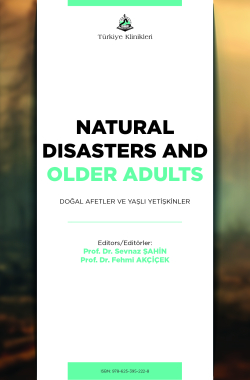Natural Disasters and Cancer in Older Adults
Fatma SERTa , Bihter ENİSELERb
aEge University Faculty of Medicine, Department of Radiation Oncology, İzmir, Türkiye
bManisa Celal Bayar University Faculty of Medicine, Department of Medical Oncology, Manisa, Türkiye
Sert F, Eniseler B. Natural disasters and cancer in older adults. In: Şahin S, Akçiçek F, eds. Natural Disasters and Older Adults. 1st ed. Ankara: Türkiye Klinikleri; 2024. p.39-44.
ABSTRACT
Older adults exposed to natural disasters are at an increased risk for a range of adverse health events, including death, injury, hospitalization, stroke, displacement, respiratory problems, mental health problems, and the worsening of chronic illnesses. Analyses of the health consequences of natural disasters typically focus on the short-term effects, neglecting the long-term impacts on the affected populations. The long-term effects of natural disasters on older adult health have largely been ignored, with few exceptions. This article discusses the potential for natural disasters to contribute to cancer and disrupt cancer care treatment systems for older adults. Exposures to floods and wildfires, in particular, are argued to pose an underestimated threat to the onset and/or progression of cancer and the management of cancer in older adults. We offer recommendations for comprehensive risk assessment and emergency preparedness models that address the full impact of natural disasters on the health and wellbeing of vulnerable, at-risk, older adults.
Keywords: Natural disasters; cancer; older adults; geriatrics
Kaynak Göster
Referanslar
- Fuchs-Heinritz W, Klimke R, Lautmann R, Rammstedt O, Wienold H. Lexikon zur Soziologie. 2. geliştirilmiş ve genişletilmiş baskı. Opladen: Westdeutscher Verlag; 1988. p.278.
- Lynch KA, Merdjanoff AA. Impact of Disasters on Older Adult Cancer Outcomes: A Scoping Review. JCO Glob Oncol. 2023;9:e2200374. [Crossref] [PubMed] [PMC]
- Adams V, Kaufman SR, van Hattum T, Moody S. Aging disaster: mortality, vulnerability, and long-term recovery among Katrina survivors. Med Anthropol. 2011;30(3):247-70. [Crossref] [PubMed] [PMC]
- Bolin R, Klenow DJ. Response of the elderly to disaster: an age-stratified analysis. Int J Aging Hum Dev. 1982-1983;16(4):283-96. [Crossref] [PubMed]
- Ozaki A, Leppold C, Tsubokura M, Tanimoto T, Saji S, Kato S, et al. Social isolation and cancer management after the 2011 triple disaster in Fukushima, Japan: A case report of breast cancer with patient and provider delay. Medicine (Baltimore). 2016;95(26):e4027. [Crossref] [PubMed] [PMC]
- El Saghir NS, Soto Pérez de Celis E, Fares JE, Sullivan R. Cancer Care for Refugees and Displaced Populations: Middle East Conflicts and Global Natural Disasters. Am Soc Clin Oncol Educ Book. 2018;38:433-40. [Crossref] [PubMed]
- Ebi KL, Hess JJ, Watkiss P. Health Risks and Costs of Climate Variability and Change. In: Mock CN, Nugent R, Kobusingye O, Smith KR, eds. Injury Prevention and Environmental Health. 3rd ed. Washington (DC): The International Bank for Reconstruction and Development / The World Bank; 2017. Chapter 8. [Crossref] [PubMed]
- Institute for Economics & Peace. Ecological Threat Report 2022: Analysis Ecological Threats, Resilience & Peace, Sydney, October 2022.
- Cherniack EP. The impact of natural disasters on the elderly. Am J Disaster Med. 2008;3(3):133-9. [Crossref] [PubMed]
- Centers for Disease Control and Prevention. (2011). Healthy aging: Helping people to live long and productive lives and enjoy a good quality of life. National Center for Chronic Disease Prevention and Health Promotion. Available from: [Link]
- Help Age. Displacement and older people The case of the Great East Japan Earthquake and Tsunami of 2011. Japanese Red Cross. 2013.
- Parry W. (2013). Why disasters like Sandy hit the elderly hard. Available from: [Link]
- Poumadère M, Mays C, Le Mer S, Blong R. The 2003 heat wave in France: dangerous climate change here and now. Risk Anal. 2005;25(6):1483-94. [Crossref] [PubMed]
- Korsiak J, Pinault L, Christidis T, Burnett RT, Abrahamowicz M, Weichenthal S. Long-term exposure to wildfires and cancer incidence in Canada: a population-based observational cohort study. Lancet Planet Health. 2022;6(5):e400-9. [Crossref] [PubMed]
- Yu P, Xu R, Li S, Yue X, Chen G, Ye T, et al. Exposure to wildfire-related PM2.5 and site-specific cancer mortality in Brazil from 2010 to 2016: A retrospective study. PLoS Med. 2022;19(9):e1004103. [Crossref] [PubMed] [PMC]
- Pun VC, Kazemiparkouhi F, Manjourides J, Suh HH. Long-Term PM2.5 Exposure and Respiratory, Cancer, and Cardiovascular Mortality in Older US Adults. Am J Epidemiol. 2017;186(8):961-9. [Crossref] [PubMed] [PMC]
- Friedrich MJ. Determining Health Effects of Hazardous Materials Released During Hurricane Harvey. JAMA. 2017;318(23):2283-5. [Crossref] [PubMed]
- Shultz JM, Galea S. Mitigating the Mental and Physical Health Consequences of Hurricane Harvey. JAMA. 2017;318(15):1437-8. [Crossref] [PubMed]
- Centers for Disease Control and Prevention (CDC). (2018). Infectious disease after a disaster. Available from: [Link]
- Mokdad AH, Mensah GA, Posner SF, Reed E, Simoes EJ, Engelgau MM; Chronic Diseases and Vulnerable Populations in Natural Disasters Working Group. When chronic conditions become acute: prevention and control of chronic diseases and adverse health outcomes during natural disasters. Prev Chronic Dis. 2005;2 Spec no(Spec No):A04.
- Ullman K. Cancer care during natural disasters. Journal of the National Cancer Institute. 2011;103:1819-20. [Crossref] [PubMed]
- Parker G, Lie D, Siskind DJ, Martin-Khan M, Raphael B, Crompton D, et al. Mental health implications for older adults after natural disasters--a systematic review and meta-analysis. Int Psychogeriatr. 2016;28(1):11-20. [Crossref]

